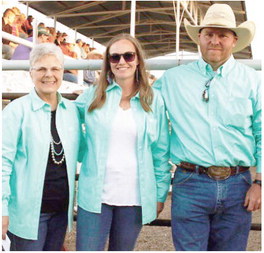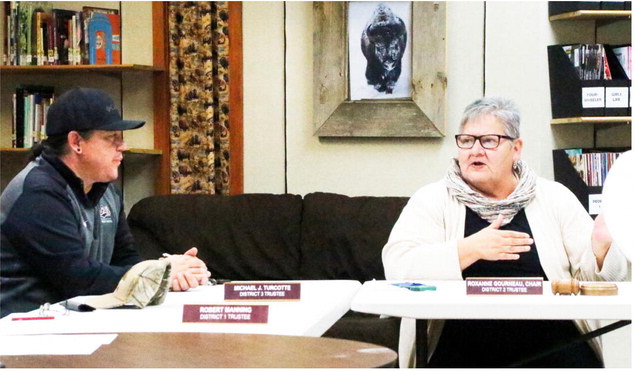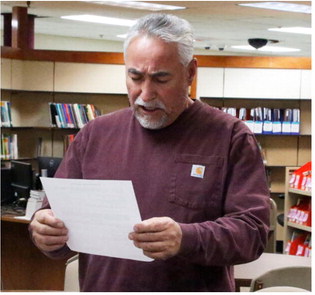Passing The Volunteer Torch


As A Generation Of Community Volunteers Ages, Transition Planning Becomes Key
Northern Plains Independent
As longtime volunteers grow older, many want to take a step back to allow for more travel and leisure time. What will volunteer organizations do to fill the void, and how can we keep older volunteers active? Many communities are struggling to find an answer.
Wolf Point’s Clint and Arlyss Long have been at the head of a small army of volunteers behind the Wild Horse Stampede, the oldest continuous rodeo in the state of Montana, for nearly 40 years. Along with the many challenges experienced across the nation in 2020, including COVID-19’s economic impacts and public health restrictions, the Stampede was faced this year with replacing its long-standing leaders. The Longs decided at the conclusion of the 2019 rodeo season to retreat from leadership roles on the Stampede committee.
“We told them at the end of the last day of the rodeo,” Arlyss said.
Clint, who served as committee chairman for 38 years beginning in the early 1980s, said his thoughts on retirement centered on a few persistent considerations.
“We had built or replaced everything but the grandstands,” he said, describing his tenure. He said that by the end of 2019, the committee had accomplished all his personal long-term infrastructure goals.
“I knew we were going to step aside eventually,” said Arlyss. She said they prioritized a smooth transition within the Stampede committee and actively courted their replacements in fellow Wolf Point residents Dave and Kay Matejovsky, along with daughter Nicole Matejovsky Paulson, who serves with her mother as co-secretary. Paulson is in her early 30s.
Most of the peripheral events regularly scheduled around the annual rodeo, now in its 97th year, were canceled in 2020 due to public health considerations. But the rodeo itself went forward, necessitating a barrage of impromptu executive and committee- based decisions and additional planning, along with serious considerations about the possibility of community spread during a pandemic.
Arlyss emphasized the utility of older volunteers, especially those with experience.
“A lot of the younger volunteers don’t immediately know how to make themselves useful,” she said, adding that an older volunteer stepping down from a leadership role can be an especially important brain trust for groups with generational provenance.
Clint said a lot of younger volunteers don’t trust themselves immediately. He said it’s important to instill a sense of confidence in aspiring leaders.
“You have to encourage them,” he said. “I would have liked to make the 100th Stampede, but I encouraged Dave [Matejovsky] to take over for a full year.”
Among the younger generations, commitment seems to be coming naturally to a select few who have taken up leadership roles in service organizations like the Stampede committee and the chamber of commerce.
Nicole Miller is manager of the Sherman Inn Hotel and Restaurant in downtown Wolf Point and a director with the Chamber of Commerce and Agriculture, a primary sponsor of the Stampede. At 26, she’s part of a younger group of volunteers active in the community.
“It’s my personality type,” said Miller, who said she joined groups, clubs and activities throughout high school, priming her for a future of volunteerism.
Once she started attending regular chamber meetings, Miller said, it was a matter of months before she was voted in as a director. It was her idea. She said she asked about directorship before anyone offered. She said young people hoping to take a leadership role in small town volunteer groups shouldn’t wait to be invited. “Put yourself forward,” Miller said. She described the reception she received as warm and occasionally curious. “People seemed to notice how young I was for a little while,” she said.
That was more than seven years ago. Today, Miller is instrumental in putting on the Stampede, Brewfest, Art in the Park, Christmas Stroll, visits from Santa and other area events.
Miller listed several benefits to picking up volunteer slack in Wolf Point. She said a willingness to participate in Main Street volunteer events leads to acknowledgment and recognition, especially for younger people seeking a role to play in the local economy.
Miller said volunteerism with the chamber has been holding steady, if not growing, during her time with the organization. “We have enough generals,” she said. “We could use some more people who are just willing to help out.”
Suzanne Shumway, 32, of Wolf Point, serves as secretary of the city’s Lions Club chapter. She said personality had nothing to do with her habit of diving into volunteer activities around the community. Shumway is a loan specialist at First Community Bank in Wolf Point. In December 2017, coworker Diane White, who had been serving as secretary for the Lions, left the bank and gave up her role with the club.
“There was nobody else to do it,” said Shumway. She was asked to help. Since accepting, she has come to enjoy the weekly lunches with club members and annual activities around the community, including pancake breakfast feeds, Adopt-a-Highway ditch cleaning, flags for first-graders and assisting with high school tournaments. Asked if she would have ended up contributing to volunteer-based groups had she not been put on the spot at work, Shumway guessed not.
“My volunteer work started with a push from someone else,” she said, “but I did it because I believe in these groups and I think what they do is important for our communities.”
According to the state Bureau of Labor and Statistics’ latest volunteerism survey, which took place in 2015, persons 65 years of age and older were volunteering an average of 94 hours per year, while other age groups were spending half that or less volunteering. People age 16-19 volunteered an average of 36 hours annually.
Shumway said she was puzzled about the obvious decline in volunteerism among millennials and neighboring generations. She said that the issues young people typically cite about busy schedules are legitimate. Volunteering takes time. It isn’t always an easy choice. “I have a family,” Shumway said. “I have a husband and kids.”
Shumway said bank staff have traditionally been active in the annual rodeo. “We feed [the] contestants,” she said.
That role was particularly needful in 2020. Due to COVID-19, rodeo participants were confined to restricted areas of the rodeo grounds and allowed out of their trailers only during competition. Shumway was part of the team charged with making sure they had plenty to eat.
Shumway is also active with the local Cub Scouts. Scouting was resurrected in Wolf Point in 2019. Shumway’s 30-year-old brother, Jo- seph Herzog, teamed up with another young father, Tyler Desjarlais, 31, of Wolf Point, who expressed a wish to see his children in scouting. The men approached Shumway and asked her to act as secretary/ treasurer.
“I couldn’t let those boys handle the money,” she joked.
“I’d like to say volunteering is a totally selfless act,” she added, “but it’s not. There may be a little selfishness in the fact that I enjoy it. I enjoy feeling like I’m making a difference. It also helps to pull me out of my comfort zone. I don’t socialize well. I’m an introvert until I get comfortable around people, and volunteering has helped me be more comfortable around new people and be more confident in myself.”
According to the 2015 BLS survey, the organization for which responding volunteers worked the most hours was most often a religious organization (33.1 percent of all volunteers), followed by educational or youth service organizations (25.2 percent). Another 14.6 percent of volunteers performed activities mostly for social or community service organizations. Older volunteers were more likely than younger ones to volunteer mainly for religious organizations. Of volunteers age 65 and over, 42.7 percent served mainly through or for a religious organization, compared with 25.4 percent of volunteers age 16 to 24.
The Longs said a significant portion of their volunteering has been through their church.
Christy Stensland, who has volunteered with the Stampede for as long as she can remember, said her family also oriented its volunteering around commitment to their church. She said the Stampede committee became a structured commitment after she married Jack Stensland in 1980.
“I was always part of a volunteer family,” said Stensland. “It was just something we did.”
She recalled group commitments to various community service organizations and church groups growing up, leading to high school clubs and activities, then adult commitments.
“The first time I can remember talking about it was when we were married,” she said.
Stensland, now in her 60s, stressed the importance of matching volunteer commitments with family values and taking those time commitments seriously. She said she and her husband selected a limited number of long-term commitments for each other and for their family early in their marriage, maximizing their time together and ensuring their ability to stick with the organizations they pledged to help.
“Jack was already involved with the Stampede committee when we married,” she said. “I joined when the kids were older, around five or six. It made it fun that we were all involved.”
Stensland said she started seeing more younger people interested in getting involved about four or five years ago. She said it’s important for senior members in volunteer organizations to help introduce younger members to the volunteer ethos: “You have to mentor volunteers, bring them along. It’s the responsibility of leaders to bring the younger people along.”
She said leaders must make room for new members. “You have to teach them how to be involved,” she said, “and you have to invite them to be involved.”
The Longs' transition out of leadership roles with the Stampede committee isn't an end to their involvement with the rodeo. The couple said they, like other volunteer leaders in their age range, are in a good position to support the causes they love with targeted participation aimed at making the most of their experience. Older volunteers often make desirable novices in community groups. Even if it's their first time volunteering, the institutional knowledge and common sense that come with age often make them critical members of an organization. With younger people in seemingly short supply, senior joiners at all levels of volunteer organizations continue to be valued at a premium.






